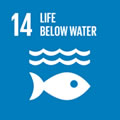Por favor, use este identificador para citar o enlazar a este item:
http://hdl.handle.net/10261/311676COMPARTIR / EXPORTAR:
 SHARE SHARE
 CORE
BASE CORE
BASE
|
|
| Visualizar otros formatos: MARC | Dublin Core | RDF | ORE | MODS | METS | DIDL | DATACITE | |

| Título: | Multigenerational physiological compensation and body size reduction dampen the effects of warming on copepods |
Autor: | de Juan Carbonell, Carlos CSIC ORCID ; Griffell Martínez, Kaiene CSIC ORCID ; Calbet, Albert CSIC ORCID ; Saiz, Enric CSIC ORCID | Fecha de publicación: | may-2023 | Citación: | Limnology and Oceanography 68(5): 1037-1047 (2023) | Resumen: | Under the current ocean warming scenario, multigenerational studies are essential to address possible adaptive changes in phenotypic traits of copepod populations. In this study, we exposed the calanoid copepod Paracartia grani, reared in the laboratory at 19°C, to warmer conditions (22°C and 25°C) to investigate the changes in key phenotypic traits in the 1st, 10th, and 11th generations. Development rates and adult body size were inversely related to temperature in all generations. We also found a decline in copepod egg size at higher temperatures. Temperature had positive effects on the ingestion and egg production rate of females in the first generation, but the thermal response of the copepods diminished significantly in the consecutive generations. The decrease in thermal effects on feeding and egg production rates after multigenerational exposure cannot be explained only by the shrinkage in body size at warmer temperatures, but also involves the action of physiological compensation. These adaptive processes did not appear to have a significant cost on other traits, such as egg hatching success, gross growth efficiency, and sex ratio. Our findings have implications for the prediction of ocean warming effects on copepod activity rates and highlight the importance of physiological adaptation processes after multigenerational exposure | Descripción: | This article is a contribution from the Marine Zooplankton Ecology Laboratory at the ICM-CSIC.-- 11 pages, 6 figures, 2 tables, supporting information https://doi.org/10.1002/lno.12327.-- Data availability statement: The data that support the conclusions of this study are openly available in Digital.CSIC repository at https://doi.org/10.20350/digitalCSIC/15130 | Versión del editor: | https://doi.org/10.1002/lno.12327 | URI: | http://hdl.handle.net/10261/311676 | DOI: | 10.1002/lno.12327 | ISSN: | 0024-3590 | E-ISSN: | 1939-5590 |
| Aparece en las colecciones: | (ICM) Artículos |
Ficheros en este ítem:
| Fichero | Descripción | Tamaño | Formato | |
|---|---|---|---|---|
| de_Juan_et_al_2023.pdf | 656,02 kB | Adobe PDF |  Visualizar/Abrir | |
| de_Juan_et_al_2023_suppl.docx | 470,22 kB | Microsoft Word XML | Visualizar/Abrir |
CORE Recommender
SCOPUSTM
Citations
3
checked on 12-may-2024
WEB OF SCIENCETM
Citations
3
checked on 18-feb-2024
Page view(s)
56
checked on 15-may-2024
Download(s)
47
checked on 15-may-2024
Google ScholarTM
Check
Altmetric
Altmetric
Este item está licenciado bajo una Licencia Creative Commons



